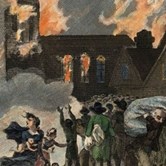 James Dalton, Director, General Insurance Policy, ABI
James Dalton, Director, General Insurance Policy, ABIThe Great Fire of London, which happened 350 years ago this September, destroyed more than 13,000 homes and 87 churches as it blazed for four days. Thousands of timber buildings, crowded together, proved highly susceptible to the flames. If such a fire engulfed the City of London today, we estimate the cost in insurance pay-outs would be £37bn.
A lot of important learning came out of the conflagration in 1666. New regulations about building construction came into being; fire-fighting teams were established for the first time ever – the pre-cursors to today’s London Fire Brigade; and the property insurance industry was born.
Nicholas Barbon, a property investor, established a company known as The Insurance Office the following year. This mutual fund took a premium from policy-holders which was invested in property and the assets were used to pay claims.
Property insurance is a vital safeguard for millions of homes and businesses today, helping people back on their feet when the worst happens. But, as the Great Fire taught us, it is equally important to prevent disaster whenever possible.
 The Great Fire began in the early hours of Sunday morning at Thomas Farriner's bakery on Pudding Lane, in the City of London.
The Great Fire began in the early hours of Sunday morning at Thomas Farriner's bakery on Pudding Lane, in the City of London.Too often, parts of our major cities are still brought to a halt by large building fires. The blaze in Battersea, south London, on 13 July is just one recent example. One hundred firefighters were needed to tackle a fire on an industrial estate which spread through eight units and caused major disruption to transport.
It will never be possible to completely eradicate this type of fire, but there is sprinkler technology to drastically reduce the chances of it taking hold and spreading. At the moment only a fifth of warehouses between 2,000 square metres and 10,000 square metres have sprinklers fitted.
Given the proliferation of ever larger warehouses stocked ceiling-high with goods in response to the boom in online shopping, the regulatory approach to sprinklers is out-of-date. There is a government recommendation that warehouses over 20,000 square metres have sprinkler systems, but there are no rules to enforce it. Instead, sprinklers should be a legal requirement and for much smaller warehouses too – any over 2,000 square metres.
The Sony warehouse case shows we cannot expect the situation to improve without a change in the law. This building was destroyed by fire during the London riots of August 2011 with the loss of 3.2m units of stock. More than £80m was paid by insurers. The replacement building still does not have sprinklers.
The average cost of commercial fire claims continues to rise and has now broken through the £25,000 barrier for the first time, but the case for modernising our fire prevention laws is not only financial. Large warehouse blazes cause major disruption and risk the lives of the firefighters sent to tackle them. New care homes and schools should also be built with sprinklers as a matter of course but, again, there is no requirement to do so. These buildings house some of the most vulnerable people in society and it is astonishing that we ignore such a straightforward way to improve their safety.
We will never see a fire on the scale of the 1666 blaze again. But 350 years since it happened, we should be doing a lot more to prevent the catastrophic losses that fire causes.
James Dalton is Director, General Insurance Policy, at the Association of British Insurers (ABI)
This blog first appeared on the City AM website on 26 July 2016, and featured in the print edition, page 16.
